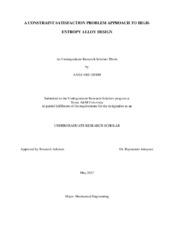| dc.description.abstract | High-entropy alloys (HEAs) are multi-principal element alloys at near-equiatomic concentrations that can have superior properties such as high irradiation resistance, high fatigue resistance, and high temperature usage, compared to conventional alloys. Because of their properties, HEAs may find applications in industries such as nuclear, aerospace, medical, and electronic. However, the design and discovery of HEAs has been largely limited to trial and error, Edisonian, methods, and only a fraction of the possibilities have been produced. A computational alloy design methodology using the constraint satisfaction problem (CSP) approach is proposed to accelerate the design and discovery of HEAs. This approach consists of three major steps: mapping design requirements into mathematical constraints and using computational thermodynamic calculations to implement them, sampling the HEA space of composition and temperature within the constraints to search for solutions, and describing the final solution space using machine learning methods. Ultimately, the CSP approach enables the identification of potentially all regions in composition space that satisfy material design requirements. A Thermo-Calc database used to encode the thermodynamic information of all phases in a given alloy system was verified against experimental data to be implemented for phase stability calculations. With kinetic considerations, 70.8% of the 216 evaluated alloys showed good agreement between experiments and calculations using the database. This database was used to map out single-phase solid solution regions for the known CoCrFeMnNi HEA and all its subsequent near-equiatomic quaternary and ternary systems. Afterwards, regions of possible precipitation hardening potential were determined in the AlCoCrFeNi system. The results demonstrate the CSP algorithm’s capability to search HEA thermodynamic space and to accelerate HEA design and discovery. | en |


